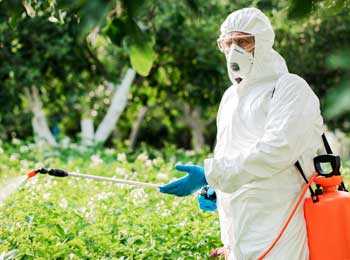How to safely apply, transport and store pesticides

By Zach Bruce
About 1 billion pounds of pesticides are used each year in the United States to control weeds, insects and pests, according to a recent study by the U.S. Geological Survey (USGS). While pesticides can provide many benefits to lawns and landscaping, they can also pose risks to users’ health, the environment, and landscaping businesses like yours. The following tips can help mitigate these risks.
Follow label directions
Always follow the label directions closely. Never work with hazardous materials, especially pesticides, without being prepared. Every chemical product provides explicit instructions for mixing, diluting and application protocols. The label will also include first-aid information, personal protective equipment (PPE) requirements and recommendations, and storage and disposal details.
Wear appropriate PPE
Anytime you’re mixing, applying or disposing of chemicals, PPE is a requirement. In fact, it’s mandated by law. PPE protects the applicator from harmful inhalation or accidental contact with the skin or mucous membranes. Pesticide poisoning can happen in the blink of an eye, literally. Review the chemical’s label, Safety Data Sheet (SDS), and manufacturer’s requirements. Based on the requirements, your staff may need to wear eye protection, chemical-resistant gloves, long sleeves and pants, boots, and a face mask or respirator. Before using protective coverings, train your team on the appropriate use of equipment to help ensure they use it effectively.
Minimize personal exposure
Avoid touching your face, mouth, or nose, especially when wearing gloves that may be contaminated. Once you’ve finished with the chemical application, thoroughly wash your hands with soap and water to remove any residues. Always assume any clothing or PPE you use during a pesticide application will be exposed to the chemical and should be washed – or tossed.
Watch weather conditions
Don’t apply pesticides in the rain or wind, both of which can cause chemicals to inadvertently infiltrate areas outside your project space. Rain washes most applications from their intended surfaces, negating the purpose of the treatment, and possibly harming nearby environments. Wind can lead to product drift, which doesn’t benefit plants in the intended area, and could negatively affect plants or people in other locations. Always wait for fair weather.
Safely transport chemicals to job sites
When transporting pesticides in company vehicles, don’t set them inside with you while driving. Ensure lids are tightened and place them in the truck’s bed or an equipment trailer going to the job site. Protect containers from weather and secure them to prevent shifting — or spilling — during transport.
Plan for spills
Take chemical cleanup very seriously. Create a company spill plan that includes a protocol in the event of a chemical spill. Include detailed information on product cleanup, disposal, and decontamination. Specify when evacuations are necessary, how to conduct evacuations, and whom to contact when spills occur. Address every spill with the following approach:
- Control: Put on appropriate PPE and immediately shut off any ignition sources capable of creating a spark. Place the lid tightly on the container and tip the container upright, if possible.
- Contain: Starting from the perimeter, spread absorbent material or neutralizing product on the spill, working toward the center. If possible, block access to the spill, preventing others from coming into contact with it.
- Clean: Collect the absorbent or neutralizing material and discard it in a protective container, such as a lidded pail or drum according to local laws or environmental regulations. Dispose of contaminated rags, gloves, brooms, dustpans and other items used to clean up.
Dispose of pesticides properly
Improper pesticide disposal can contaminate soil, groundwater and surface water, causing serious liability problems. Never throw away containers without following label directions, local laws and environmental regulations. Never burn or incinerate chemical containers, as the fumes are toxic. Contact your local Department of Natural Resources (DNR) for state-specific guidelines.
Store properly
Federal and state regulations impact how you store pesticides at your landscaping business. If your company uses portable containers, such as 55-gallon drums or smaller, visit the EPA’s storage page. If you rely more on stationary containers that are 500 gallons or lager, the EPA’s containment page can provide more information.
Also consider any added risks that could result from a spill, fire or flood in your storage area. Set up a conversation or facility tour with your local fire department. The type and location of pesticides on your property can help the fire department better understand how to respond to an emergency without worsening a spill or fire.
Protect your bottom line with insurance coverages
Even when you and your team take precautions, individuals outside your team might claim your business caused damage to them or their property due to spraying, drifting, or transporting chemicals. Consider adding an extra layer of protection to your business with general liability coverage or chemical application coverage. Since policies and exclusions can vary, talk with your insurer to understand what risks your current policy covers. Adding insurance that complements your business’s safety efforts can help provide stronger protection and peace of mind.
Landscaping is a rewarding profession. Don’t let the hazards of the business diminish those rewards. Use the guidelines provided above, consistently train your staff on safety procedures, and don’t take short cuts when dealing with pesticides. Visit the EPA’s website to stay updated on the latest information and consult your local experts or attorney.
Zach Bruce is the safety services manager for Hortica, a brand of the Sentry Insurance Group. He works with horticultural businesses throughout the industry to improve safety and reduce risks. Visit Hortica.com to learn more.


